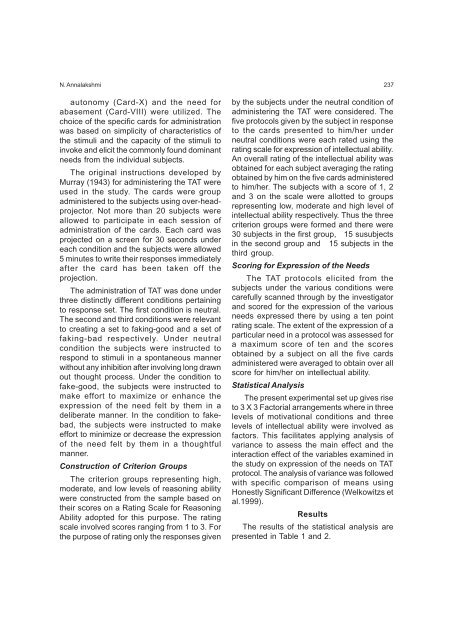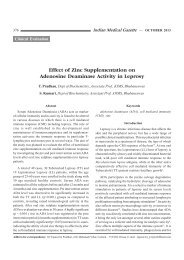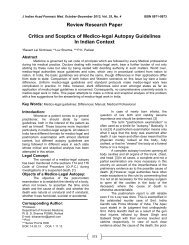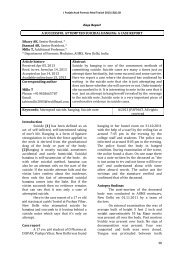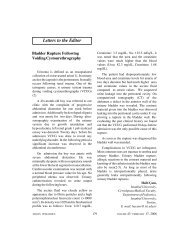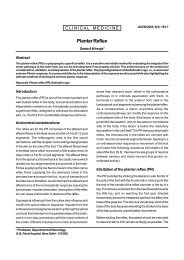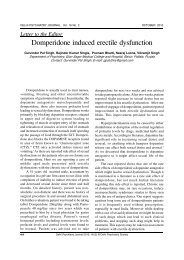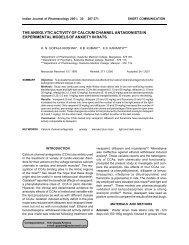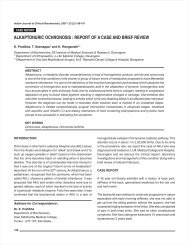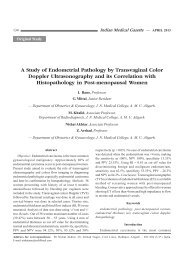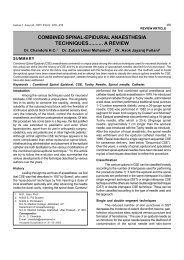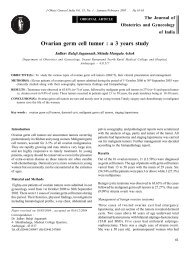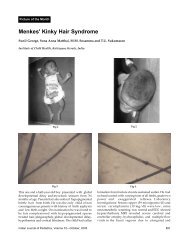TAT Responses in Relation to Induced Motivational Set ... - medIND
TAT Responses in Relation to Induced Motivational Set ... - medIND
TAT Responses in Relation to Induced Motivational Set ... - medIND
You also want an ePaper? Increase the reach of your titles
YUMPU automatically turns print PDFs into web optimized ePapers that Google loves.
N. Annalakshmi 237<br />
au<strong>to</strong>nomy (Card-X) and the need for<br />
abasement (Card-VIII) were utilized. The<br />
choice of the specific cards for adm<strong>in</strong>istration<br />
was based on simplicity of characteristics of<br />
the stimuli and the capacity of the stimuli <strong>to</strong><br />
<strong>in</strong>voke and elicit the commonly found dom<strong>in</strong>ant<br />
needs from the <strong>in</strong>dividual subjects.<br />
The orig<strong>in</strong>al <strong>in</strong>structions developed by<br />
Murray (1943) for adm<strong>in</strong>ister<strong>in</strong>g the <strong>TAT</strong> were<br />
used <strong>in</strong> the study. The cards were group<br />
adm<strong>in</strong>istered <strong>to</strong> the subjects us<strong>in</strong>g over-headprojec<strong>to</strong>r.<br />
Not more than 20 subjects were<br />
allowed <strong>to</strong> participate <strong>in</strong> each session of<br />
adm<strong>in</strong>istration of the cards. Each card was<br />
projected on a screen for 30 seconds under<br />
each condition and the subjects were allowed<br />
5 m<strong>in</strong>utes <strong>to</strong> write their responses immediately<br />
after the card has been taken off the<br />
projection.<br />
The adm<strong>in</strong>istration of <strong>TAT</strong> was done under<br />
three dist<strong>in</strong>ctly different conditions perta<strong>in</strong><strong>in</strong>g<br />
<strong>to</strong> response set. The first condition is neutral.<br />
The second and third conditions were relevant<br />
<strong>to</strong> creat<strong>in</strong>g a set <strong>to</strong> fak<strong>in</strong>g-good and a set of<br />
fak<strong>in</strong>g-bad respectively. Under neutral<br />
condition the subjects were <strong>in</strong>structed <strong>to</strong><br />
respond <strong>to</strong> stimuli <strong>in</strong> a spontaneous manner<br />
without any <strong>in</strong>hibition after <strong>in</strong>volv<strong>in</strong>g long drawn<br />
out thought process. Under the condition <strong>to</strong><br />
fake-good, the subjects were <strong>in</strong>structed <strong>to</strong><br />
make effort <strong>to</strong> maximize or enhance the<br />
expression of the need felt by them <strong>in</strong> a<br />
deliberate manner. In the condition <strong>to</strong> fakebad,<br />
the subjects were <strong>in</strong>structed <strong>to</strong> make<br />
effort <strong>to</strong> m<strong>in</strong>imize or decrease the expression<br />
of the need felt by them <strong>in</strong> a thoughtful<br />
manner.<br />
Construction of Criterion Groups<br />
The criterion groups represent<strong>in</strong>g high,<br />
moderate, and low levels of reason<strong>in</strong>g ability<br />
were constructed from the sample based on<br />
their scores on a Rat<strong>in</strong>g Scale for Reason<strong>in</strong>g<br />
Ability adopted for this purpose. The rat<strong>in</strong>g<br />
scale <strong>in</strong>volved scores rang<strong>in</strong>g from 1 <strong>to</strong> 3. For<br />
the purpose of rat<strong>in</strong>g only the responses given<br />
by the subjects under the neutral condition of<br />
adm<strong>in</strong>ister<strong>in</strong>g the <strong>TAT</strong> were considered. The<br />
five pro<strong>to</strong>cols given by the subject <strong>in</strong> response<br />
<strong>to</strong> the cards presented <strong>to</strong> him/her under<br />
neutral conditions were each rated us<strong>in</strong>g the<br />
rat<strong>in</strong>g scale for expression of <strong>in</strong>tellectual ability.<br />
An overall rat<strong>in</strong>g of the <strong>in</strong>tellectual ability was<br />
obta<strong>in</strong>ed for each subject averag<strong>in</strong>g the rat<strong>in</strong>g<br />
obta<strong>in</strong>ed by him on the five cards adm<strong>in</strong>istered<br />
<strong>to</strong> him/her. The subjects with a score of 1, 2<br />
and 3 on the scale were allotted <strong>to</strong> groups<br />
represent<strong>in</strong>g low, moderate and high level of<br />
<strong>in</strong>tellectual ability respectively. Thus the three<br />
criterion groups were formed and there were<br />
30 subjects <strong>in</strong> the first group, 15 susubjects<br />
<strong>in</strong> the second group and 15 subjects <strong>in</strong> the<br />
third group.<br />
Scor<strong>in</strong>g for Expression of the Needs<br />
The <strong>TAT</strong> pro<strong>to</strong>cols elicited from the<br />
subjects under the various conditions were<br />
carefully scanned through by the <strong>in</strong>vestiga<strong>to</strong>r<br />
and scored for the expression of the various<br />
needs expressed there by us<strong>in</strong>g a ten po<strong>in</strong>t<br />
rat<strong>in</strong>g scale. The extent of the expression of a<br />
particular need <strong>in</strong> a pro<strong>to</strong>col was assessed for<br />
a maximum score of ten and the scores<br />
obta<strong>in</strong>ed by a subject on all the five cards<br />
adm<strong>in</strong>istered were averaged <strong>to</strong> obta<strong>in</strong> over all<br />
score for him/her on <strong>in</strong>tellectual ability.<br />
Statistical Analysis<br />
The present experimental set up gives rise<br />
<strong>to</strong> 3 X 3 Fac<strong>to</strong>rial arrangements where <strong>in</strong> three<br />
levels of motivational conditions and three<br />
levels of <strong>in</strong>tellectual ability were <strong>in</strong>volved as<br />
fac<strong>to</strong>rs. This facilitates apply<strong>in</strong>g analysis of<br />
variance <strong>to</strong> assess the ma<strong>in</strong> effect and the<br />
<strong>in</strong>teraction effect of the variables exam<strong>in</strong>ed <strong>in</strong><br />
the study on expression of the needs on <strong>TAT</strong><br />
pro<strong>to</strong>col. The analysis of variance was followed<br />
with specific comparison of means us<strong>in</strong>g<br />
Honestly Significant Difference (Welkowitzs et<br />
al.1999).<br />
Results<br />
The results of the statistical analysis are<br />
presented <strong>in</strong> Table 1 and 2.


